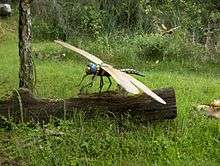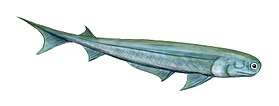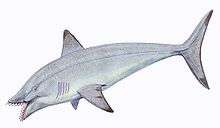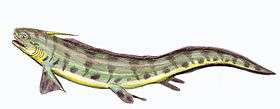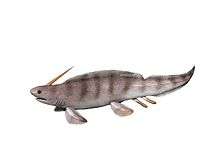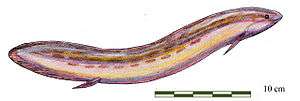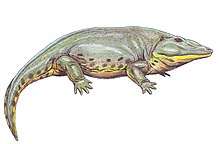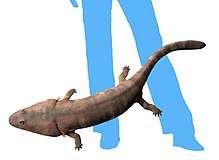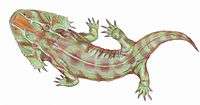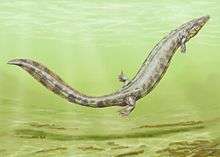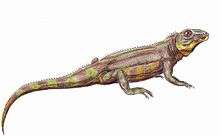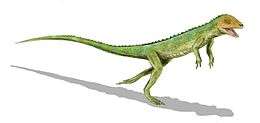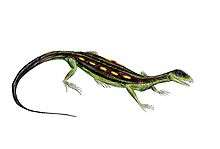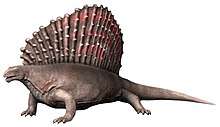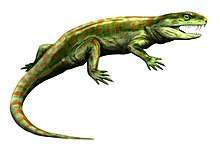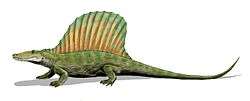Artinskian
In the geologic timescale, the Artinskian is an age or stage of the Permian. It is a subdivision of the Cisuralian epoch or series. The Artinskian likely lasted between 290.1 and 283.5 million years ago (Ma) according to the most recent revision of the International Commission on Stratigraphy (ICS) in 2013,[2] though older versions of the ICS preferred a younger age range. It was preceded by the Sakmarian and followed by the Kungurian.
| System/ Period |
Series/ Epoch |
Stage/ Age |
Age (Ma) | |
|---|---|---|---|---|
| Triassic | Lower/ Early |
Induan | younger | |
| Permian | Lopingian | Changhsingian | 251.902 | 254.14 |
| Wuchiapingian | 254.14 | 259.1 | ||
| Guadalupian | Capitanian | 259.1 | 265.1 | |
| Wordian | 265.1 | 268.8 | ||
| Roadian | 268.8 | 272.95 | ||
| Cisuralian | Kungurian | 272.95 | 283.5 | |
| Artinskian | 283.5 | 290.1 | ||
| Sakmarian | 290.1 | 295.0 | ||
| Asselian | 295.0 | 298.9 | ||
| Carboniferous | Pennsylvanian | Gzhelian | older | |
| Subdivision of the Permian system according to the ICS, as of 2017.[1] | ||||
Stratigraphy

The Artinskian is named after the small Russian city of Arti (formerly Artinsk), situated in the southern Ural mountains, about 200 km southwest of Yekaterinburg. The stage was introduced into scientific literature by Alexander Karpinsky in 1874.[3]
Base of the Artinskian
The base of the Artinskian stage is defined as the first appearance datum (FAD) of the conodont species Sweetognathus whitei and Mesogondolella bisselli. In order to constrain this age, the ICS subcommission on Permian stratigraphy informally proposed a candidate GSSP in 2002, later followed by a formal proposal in 2013. This candidate GSSP is the Dal'ny Tulkas roadcut in the Southern Urals, near the town of Krasnousolsky.[2]
U-Pb radiometric dating found that the base of the Artinskian was approximately 290.1 million years old (Ma), based on the position of the rock layer at the Dal'ny Tulkas roadcut containing the FAD of S. whitei relative to three precisely dated ash beds surrounding it.[4] Earlier radiometric reported a much younger age of 280.3 Ma for the Sakmarian-Artinskian boundary.
Top of the Artinskian
The top of the Artinskian (and the base of the Kungurian) is defined as the place in the stratigraphic record where fossils of conodonts Neostreptognathodus pnevi and Neostreptognathodus exculptus first appear.[3]
Artinskian life
Arthropods
| Arthropoda of the Artinskian | ||||
|---|---|---|---|---|
| Taxa | Presence | Location | Description | Images |
| Cisuralian | Wellington Formation, Kansas and Oklahoma, United States | A dragonfly with a wingspan over 70 cm (28 in) |
| |
Cartilaginous fishes
| Chondrichthyes of the Artinskian | ||||
|---|---|---|---|---|
| Taxa | Presence | Location | Description | Images |
| Carboniferous to Cisuralian | Germany | An acanthodian |
| |
| Carboniferous to Cisuralian | Russia | A eugeneodontid holocephalian | ||
| Cisuralian | Russia, Australia | An eugeneodont holocephalian, "buzzsaw shark" | ||
|
Carboniferous to Cisuralian | Germany | A xenacanthidan elasmobranch | |
|
Carboniferous to Cisuralian | Germany | A xenacanthidan elasmobranch | |
Ray-finned fishes
| Actinopterygii of the Artinskian | ||||
|---|---|---|---|---|
| Taxa | Presence | Location | Description | Images |
| Carboniferous to Cisuralian | Czech Republic | An aeduellid non-neopterygian |
| |
| Cisuralian | Czech Republic, France | An amblypterid non-neopterygian | ||
Lungfishes
| Dipnoi of the Artinskian | ||||
|---|---|---|---|---|
| Taxa | Presence | Location | Description | Images |
| Carboniferous to Early Triassic | North America |
| ||
| Carboniferous to Cisuralian | Germany | |||
†Temnospondyls
| Temnospondyli of the Artinskian | ||||
|---|---|---|---|---|
| Taxa | Presence | Location | Description | Images |
| Cisuralian | Texas, United States | A temnospondyl |
| |
| Cisuralian | Texas | A temnospondyl of uncertain affinities. | ||
| Cisuralian | Abo Formation, New Mexico and Seymour, Baylor County, Texas | |||
| Texas, New Mexico, Oklahoma, United States | A zatracheidid. | |||
†Embolomerians
| Embolomeri of the Artinskian | ||||
|---|---|---|---|---|
| Taxa | Presence | Location | Description | Images |
| Cisuralian | Texas, USA | A reptiliomorph |
| |
†Seymouriamorphs
| Seymouriamorpha of the Artinskian | ||||
|---|---|---|---|---|
| Taxa | Presence | Location | Description | Images |
| Boskovice Furrow, Czech Republic | A reptiliomorph |
| ||
|
USA Tambach Formation, Germany |
A reptiliomorph | ||
†Diadectomorphs
| Diadectomorpha of the Artinskian | ||||
|---|---|---|---|---|
| Taxa | Presence | Location | Description | Images |
| Cisuralian | North America | A reptiliomorph |
| |
| Cisuralian | Germany | A reptiliomorph | ||
†Mesosaurs
| Mesosauria of the Artinskian | ||||
|---|---|---|---|---|
| Taxa | Presence | Location | Description | Images |
| Cisuralian | Irati Formation, Paraná Basin, Brazil | earliest aquatic reptile |
| |
| Cisuralian | Brazil Mangrullo Formation, Uruguay Namibia South Africa |
earliest aquatic reptile | ||
| Cisuralian | Brazil South Africa |
earliest aquatic reptile | ||
†Procolophonomorphs
| Procolophonomorpha of the Artinskian | ||||
|---|---|---|---|---|
| Taxa | Presence | Location | Description | Images |
| Cisuralian | Europe | A genus of lizard-shaped parareptile |
| |
| Cisuralian | North America and North Asia | A genus of lizard-shaped parareptile | ||
| Cisuralian | Oklahoma, United States | A lanthanosuchoid parareptile | ||
| Cisuralian | Germany | A genus of biped lizard-shaped parareptile | ||
Eureptilians
| Eureptilia of the Artinskian | ||||
|---|---|---|---|---|
| Taxa | Presence | Location | Description | Images |
| Cisuralian | North America and Europe | A captorhinid reptile |
| |
| Cisuralian | United States | A captorhinid reptile | ||
Diapsids
| Diapsida of the Artinskian | ||||
|---|---|---|---|---|
| Taxa | Presence | Location | Description | Images |
| Cisuralian | North America | One of the earliest diapsids |
| |
Synapsids
| Synapsida of the Artinskian | ||||
|---|---|---|---|---|
| Taxa | Presence | Location | Description | Images |
| Cisuralian | Wichita Group, Texas, United States | A sphenacodontid |
| |
| Sakmarian-Kungurian | Greene Formation, Ohio; Belle Plains Formation, Texas; Cutler Formation, Utah, all in the USA | A sphenacodontid | ||
| Cisuralian | United States, Canada | A sphenacodontid | ||
| Pennsylvanian to Cisuralian | United States, Germany | An edaphosaurid. One of the oldest herbivorous amniotes | ||
| Cisuralian | United States | A caseasaurian | ||
| Cisuralian | United States | A caseasaurian | ||
| Kasimovian-Kungurian | Kenilworth, Kenilworth Sandstone Formation, Warwickshire Group, Warwickshire, England; Autun, France, Cutler Formation, Arizona, Colorado, New Mexico and Utah; Fort riley, Chase Group, Kansas, Greene Formation, Dunkard Group, Ohio; Wellington Formation, Oklahoma; Clyde Formation, Texas and Oklahoma; Admiral Formation; Belle-Plains Formation; Wichita Group, all three in Texas, | |||
| Cisuralian | United States | A caseasaurian | ||
| Wichita Group and Clear Fork Group, both in Texas, USA | ||||
| Gzhelian-Artinskian | New Mexico; Utah-Arizona border region, both in USA; possibly England | The English specimen known as S?. brittanicus) is now generally classified as Sphenacodontidae incertae sedis, separate from the other Sphenacodon species so may need reassigning. | ||
References
- "Chart/Time Scale". www.stratigraphy.org. International Commission on Stratigraphy.
- Chuvashov, Boris I.; Chernykh, Valery V.; Shen, Shuzhong; Henderson, Charles M. (2013). "Proposal for the Global Stratotype Section and Point (GSSP) for the base-Artinskian Stage (Lower Permian)". Permophiles. 58: 26–34.
- Gradstein, Felix M.; Ogg, James G.; Smith, Alan G. (2004). A Geologic Time Scale 2004. ISBN 9780521786737.
- Schmitz, Mark D.; Davydov, Vladimir I. (March–April 2012). "Quantitative radiometric and biostratigraphic calibration of the Pennsylvanian–Early Permian (Cisuralian) time scale and pan-Euramerican chronostratigraphic correlation". Geological Society of America Bulletin. 124 (3/4): 549–577. doi:10.1130/B30385.1.
External links
- GeoWhen Database - Artinskian
- Upper Paleozoic stratigraphic chart at the website of the subcommission for stratigraphic information of the ICS
